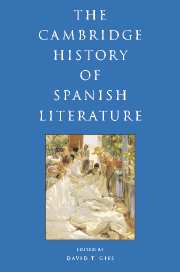Book contents
- Frontmatter
- I INTRODUCTION
- II HISTORY AND CANONICITY
- III THE MEDIEVAL PERIOD
- IV EARLY MODERN SPAIN: RENAISSANCE AND BAROQUE
- V THE ENLIGHTENMENT AND NEOCLASSICISM
- VI THE FORGING OF A NATION: THE NINETEENTH CENTURY
- VII THE MODERN, MODERNISMO, AND THE TURN OF THE CENTURY
- VIII TWENTIETH-CENTURY SPAIN AND THE CIVIL WAR
- IX IN AND OUT OF FRANCO SPAIN
- 46 The literature of Franco Spain, 1939–1975
- 47 Twentieth-century literature in exile
- 48 Prose in Franco Spain
- 49 Poetry in Franco Spain
- 50 Theatre in Franco Spain
- 51 Film and censorship under Franco, 1937–1975
- X POST-FRANCO SPANISH LITERATURE AND FILM
- Bibliography
- Index
49 - Poetry in Franco Spain
from IX - IN AND OUT OF FRANCO SPAIN
Published online by Cambridge University Press: 28 March 2008
- Frontmatter
- I INTRODUCTION
- II HISTORY AND CANONICITY
- III THE MEDIEVAL PERIOD
- IV EARLY MODERN SPAIN: RENAISSANCE AND BAROQUE
- V THE ENLIGHTENMENT AND NEOCLASSICISM
- VI THE FORGING OF A NATION: THE NINETEENTH CENTURY
- VII THE MODERN, MODERNISMO, AND THE TURN OF THE CENTURY
- VIII TWENTIETH-CENTURY SPAIN AND THE CIVIL WAR
- IX IN AND OUT OF FRANCO SPAIN
- 46 The literature of Franco Spain, 1939–1975
- 47 Twentieth-century literature in exile
- 48 Prose in Franco Spain
- 49 Poetry in Franco Spain
- 50 Theatre in Franco Spain
- 51 Film and censorship under Franco, 1937–1975
- X POST-FRANCO SPANISH LITERATURE AND FILM
- Bibliography
- Index
Summary
The Generation of 1927 in Franco’s Spain
Only three ranking members of the Generation of 1927 remained in Spain at the end of the Civil War: Dámaso Alonso (1898–1990), Vicente Aleixandre (1898–1984), and Gerardo Diego (1896–1987).
In the pre-War period Alonso had gained respect and notoriety as a historian, a philologist, and the scholarly promoter of the tercentennial commemoration of Góngora’s death in 1927. Yet, with his 1944 book Hijos de la ira (“Children of Wrath”), Alonso positioned himself as the leading figure in the movement to “rehumanize” poetry, a tendency which emerged in the years immediately after the Spanish Civil War. This watershed collection deviates from the norms of Garcilasian Neoclassicism, fusing elements of Surrealist “humanization” with the “impurity” of Neruda and Vallejo, and approximating an incipient mode of social poetry, particularly in its treatment of existential anguish and religious distress. The impact of Hijos de la ira is fueled by its disquieting imagery, by its Expressionist language culled from the semantic fields of the degraded, the violent, and the repugnant, and by the fiery rhythm of its longish lines. At its core, the book is rooted in an acknowledgment of the injustice and hostile absurdity of reality. The collection presents man not merely as a victim of this reality, but, moreover, as a subject who has come to identify with – and even to see himself as a part of – Nature’s intrinsic wrath. Faced with this human tragedy, Alonso appeals to the figure of an indifferent God as he poses unanswerable, yet inevitable, questions concerning the meaning of life, solitude, and death.
- Type
- Chapter
- Information
- The Cambridge History of Spanish Literature , pp. 643 - 658Publisher: Cambridge University PressPrint publication year: 2005



